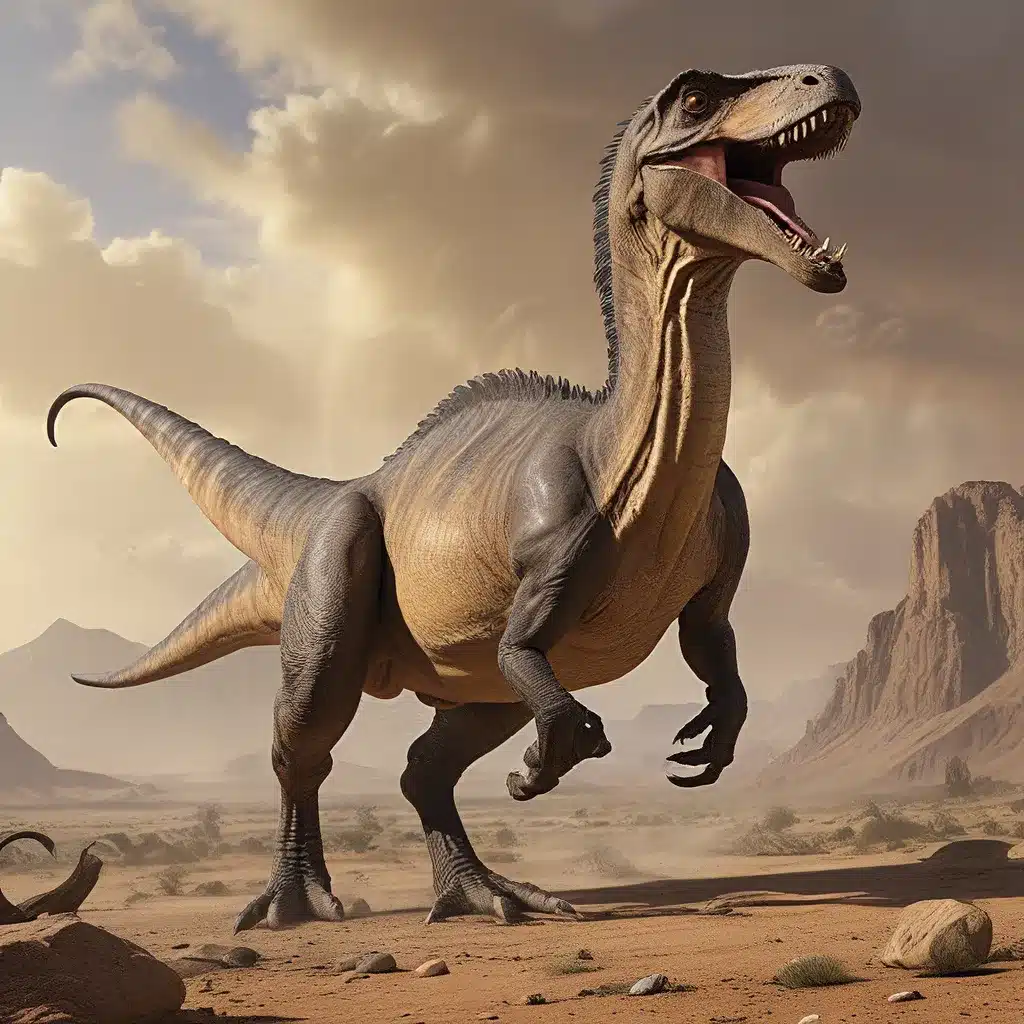
In the vast expanse of the Cretaceous period, a remarkable discovery has shed light on the intricate web of ancient predator-prey dynamics. The unearthing of Ulughbegsaurus uzbekistanensis, a newly identified species of carcharodontosaurid dinosaur, has provided a tantalizing glimpse into the dominance of these fearsome predators and the gradual rise of their tyrannosauroid counterparts.
The Reign of the Carcharodontosaurids
For much of the Cretaceous, the allosauroids, including the carcharodontosaurids, reigned supreme as the largest terrestrial predators on Earth. These formidable carnivores, with their serrated, blade-like teeth and massive jaws, were the undisputed kings of their domains. The discovery of Ulughbegsaurus in the Bissekty Formation of the Kyzylkum Desert in Uzbekistan serves as a testament to their enduring presence in Central Asia.
Estimates based on the size of the recovered maxilla (upper jawbone) fragment suggest that Ulughbegsaurus was a truly impressive creature, measuring at least 7 meters in length and weighing over a metric ton. This makes it the largest predator known from the region, dwarfing the contemporaneous tyrannosauroid Timurlengia euotica, which was a mere 3-4 meters long and approximately 8 times lighter.
The dominance of carcharodontosaurids over their tyrannosauroid counterparts persisted until around 90 million years ago, during the Turonian faunal stage of the Cretaceous. This discovery of Ulughbegsaurus represents the latest known occurrence of carcharodontosaurids in Laurasia, suggesting that they remained the apex predators in Asia even as their reign was drawing to a close in other regions.
The Shift in Predatory Dominance
The eventual decline of the carcharodontosaurids marked a significant turning point in the evolution of terrestrial predators. As these formidable carnivores faced extinction, the tyrannosauroids seized the opportunity to expand their dominance, eventually becoming the apex predators in most Laurasian ecosystems.
Evidence of larger tyrannosauroids is not known until the Campanian stage of the Cretaceous, some 7 million years after the time of Ulughbegsaurus and Timurlengia. This suggests a period of relative instability and uncertainty in the dynamics of apex predator evolution, a gap that the fossil record has yet to fully illuminate.
The Dromaeosaurid Mystery
Alongside the dominance of carcharodontosaurids and the rise of tyrannosauroids, another group of theropod dinosaurs, the dromaeosaurids, also played a significant role in the ancient ecosystems. These agile, ferocious predators, often referred to as “raptors,” were a formidable presence in many Cretaceous environments.
The discovery of Ulughbegsaurus has also hinted at the presence of a “as yet unnamed large dromaeosaurid” that may have served as a secondary predator alongside the smaller Timurlengia. This tantalizing clue suggests that the dromaeosaurid empire may have been a complex and intricate part of the ancient Laurasian food web, with different species occupying various ecological niches.
Unlocking the Secrets of the Kyzylkum Desert
The Bissekty Formation in the Kyzylkum Desert of Uzbekistan has proven to be a veritable treasure trove for paleontologists, yielding a diverse array of theropod dinosaurs, including the newly identified Ulughbegsaurus. This region has provided a rare glimpse into the ancient predator-prey dynamics that shaped the Laurasian landscape during the Late Cretaceous.
The discovery of Ulughbegsaurus fills a significant geographic gap in the distribution of carcharodontosaurids, bridging the gap between their known occurrences in Europe and East Asia. This underscores the importance of continued exploration and research in understudied regions, as these efforts can uncover critical pieces of the prehistoric puzzle.
Implications and Future Directions
The study of Ulughbegsaurus and its role in the ancient ecosystem has far-reaching implications for our understanding of theropod evolution and the dynamics of apex predator succession. The persistence of carcharodontosaurids as the dominant predators in Asia, even as their reign was coming to an end elsewhere, raises intriguing questions about the factors that influenced their decline and the rise of tyrannosauroids.
As the scientific community continues to unravel the mysteries of the Cretaceous, the discovery of Ulughbegsaurus and the insights it provides offer a tantalizing glimpse into the complex and ever-evolving world of dinosaur supremacy. Future explorations and ongoing research in the Kyzylkum Desert and other regions may yield further clues to the intricate relationships and power dynamics that defined the prehistoric landscapes.
By piecing together these fragments of the ancient past, we can gain a deeper understanding of the evolutionary processes that shaped the iconic predators that once roamed the Earth. The story of the Ulughbegsaurus and the vanished dromaeosaurid empire is but one chapter in the grand saga of dinosaur history, inviting us to continue our journey of discovery and unraveling the enduring mysteries of the prehistoric world.


